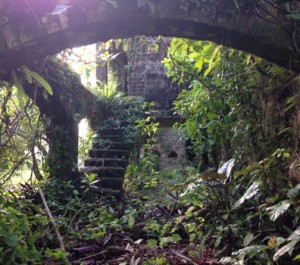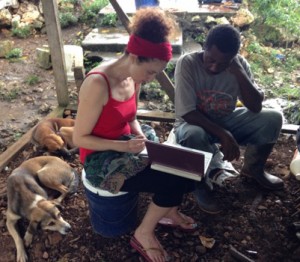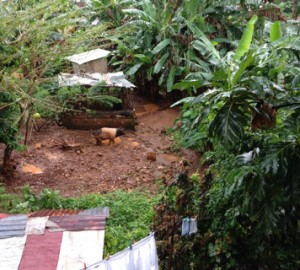Every Bush Has a Use, Every Bush Has a Meaning
Posted in Travelogue on July 20, 2015 by Ina Vandebroek
Ina Vandebroek, Ph.D., is the Matthew Calbraith Perry Assistant Curator of Economic Botany and Director of the Caribbean Program at The New York Botanical Garden. An ethnomedical research specialist, she studies people’s cultural knowledge, beliefs, and practices related to traditional medicine.

It was my last interview during one of my ethnobotanical field trips to a farming community in the lush northeast parish of Portland in Jamaica. I sat on the porch of the home of Faye, a female farmer, while the sun was setting behind the beautiful John Crow Mountains that surround the community. We looked at a set of pictures on my laptop. They were photos of plants growing in and around the community. For each one, I asked Faye if she knew the plant’s local name (or names) and its cultural uses, especially for healthcare. In rural Jamaica, people still rely greatly on wild plants (or, as they say in Jamaican patois, “bush”). They use many of these plants to treat ill health or enjoy them as a cup of tea in the morning to stay strong and energized.
Interviewing people is a standard method in ethnobotanical research. Through individual interviews with several people in the community who self-medicate with “bush medicines,” I am hoping to develop a database of locally useful plants and to understand the myriad of ways in which these plants are used. I am also trying to find out which bush plants people know best, and who is especially knowledgeable about them. These data can be used to compare culturally important plants and popularly known medicinal uses for them across several Caribbean countries. The ultimate goal is to give back that information to the community, so that these precious oral traditions do not disappear.
Faye and I had gone through many pictures already, and she had patiently explained to me the names and uses of the plants she knew. Then we came to a plant that she did not know very well, and in patois she told me, “Me cyaan [cannot] really remember that one, but every bush has a use, a meaning. For every sickness in a people body the bush is there.” That statement struck me as powerful, for several reasons.

First, it provides a clue about the rich knowledge of useful plants that still exists in the Caribbean. When people ask me about a specific medicinal use of a plant in the Dominican Republic, my standard answer is, “Let me check the database of 3,223 plant uses that we developed from fieldwork, because I do not remember each of them by heart.” From my preliminary interviews in Jamaica, and a review of the literature on previous studies in Jamaica, the same seems to be true here.
Second, many people in rural Jamaica have to rely on plants for healthcare because they have no alternative. Peter, another farmer from the community whom I interviewed, said, “Some of us out here, we can’t afford a doctor, so we use herbs for medicinal purpose.” Medicinal plants, thus, are used out of sheer necessity.
Third, knowledge about plants is not random, but patterned. Sometimes ethnobotany is criticized for consisting of “anecdotal” information that is difficult to understand scientifically. The opposite is true. By comparing people’s answers about plants, ethnobotanists are able to understand which plants have a limited number of medicinal uses and are widely known among people, as compared to poorly known plants or plants with seemingly many different uses. Ethnobotanists are also able to trace family ties in large datasets of plant knowledge. This shows that there is a system in plant use. It also tells us that this oral tradition is transmitted across family lines. Plant knowledge is part of the cultural patrimony of each community.

These are just a few of the reasons why I love both fieldwork and the post-fieldwork phase of analyzing research data. I get to spend time with wise people, who teach me about their culture and their connections with nature. It is exciting to have a glimpse into that rich diversity of knowledge, to realize that this information is very relevant to local healthcare, and finally, to discover the hidden meaning within the data. By giving back that information to the community, I hope that my scientific skills are being put to good use.
Dr. Vandebroek is conducting this research project with support from the National Geographic Society. She is collaborating with Jamaican community members; researchers from the University of the West Indies, Dr. Sylvia Mitchell and Dr. David Picking; Andreas Oberli, an endemic plant specialist working in Jamaica; and Dr. Brian Boom of The New York Botanical Garden.

